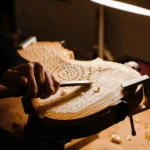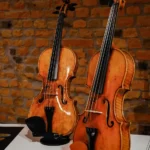Top 5 Most Charming Violin Scroll Designs of All Times
Back to BlogViolin Scrolls: carved into the tops of fine violins, violas and cellos are distinctive scroll designs, the decorative woodcarving that showcases the violinmaker’s skill as a maker and craftsman. Originated in the Baroque era, they are typically carved as a shape of a volute or rolled up the spiral and have also appeared as human or animal heads.
The volute shape of the scroll might be the most common thing among violins, but each one of them is unique. The type of scroll motif is called a Vitruvian Scroll, named after a Roman architectural historian from the first century. Some studies indicate that at the time, the motif was used to symbolize heavenly power and harmony, just like the waves of the ocean. Interesting and for sure very deep!
But today, we want to bring a selection of the most beautiful scrolls ever made!
The ‘Messiah’ Stradivarius violin, Cremona, circa 1716
The violin called Messiah has a colorful past. It is probably one of the instruments made by the famous violin maker Antonio Stradivari, and it was kept in an English museum until recently.
Antonio Stradivari, the greatest violin maker in history, was born in or around Cremona in 1644. His 71-year career is a vivid account of early mastery, fluid and ingenious innovation, and indelible craftsmanship and artistry.
Il Cannone by Guarneri del Gesù
Owned by Paganini, the whole violin is a beauty! The illustrious member of the Guarneri family was Bartolomeo Giuseppe Guarneri (Cremona, Italy, 1698-1744), a violin maker whose labels bore the Greek abbreviation for Jesus (IHS) beneath a cross indicating veneration for the holy name.
The ‘Cannon’ violin possesses a number of features that would seem to complicate its playability. It has a long string length of 330 mm: long but within the normal range. Its stop length is 198 mm (the standard is 195 mm), yet the neck is slightly shorter at 128.5 mm than the modern standard of 130 mm and is thicker at the heel, which may create a sense of discomfort for modern players.
‘The King’, Andrea Amati Cello, Cremona circa 1538
Andrea Amati founded the Amati dynasty, which is considered by some to be the “first family of strings.” Though he didn’t single-handedly create the modern violin family, he did establish and standardize the construction of many string instruments, including cellos and violas.
The King is the earliest surviving bass of the violin family; it may have been built as early as 1538. It was later painted, perhaps in 1560, to become a member of a set of 38 stringed instruments built by Andrea Amati for the French court of King Charles IX. The King’s mother was Catherine de’ Medici, a member of the family that directed the destiny of Florence.
Gaetano Gadda violin, Mantua 1951
Once Scarampella’s true follower, Gaetano Gadda began his apprenticeship in violin making in 1919 under his sole teacher. During Scarampella’s later years, Gadda used to play a key role in the production of his instruments, and in 1924 he agreed to supply Scarampella with one violin per month in exchange for his teacher’s tools and models.
Gadda’s craftsmanship improved over time, and by the war years his instruments were often considered among the best of the 20th-century Italian school. Gaily flamed maple, sometimes in two pieces, was his favorite tonewood. He loved to use deep red, lusty varnish on his instruments, which later bore his initials “G.G.”
Peregrino Michelli Di Zanetto, Brescia, c. 1560
Maggini was born in 1580 when Botticino Sera was still part of the Venetian Republic. His father died in 1595, and he moved to Brescia to work with Gasparo da Salò. He began to work some time independently after 1606 when his mother died.
There is air of mystery surrounding Peregrino Micheli, a mysterious maker from the dawn of violin-family history.









